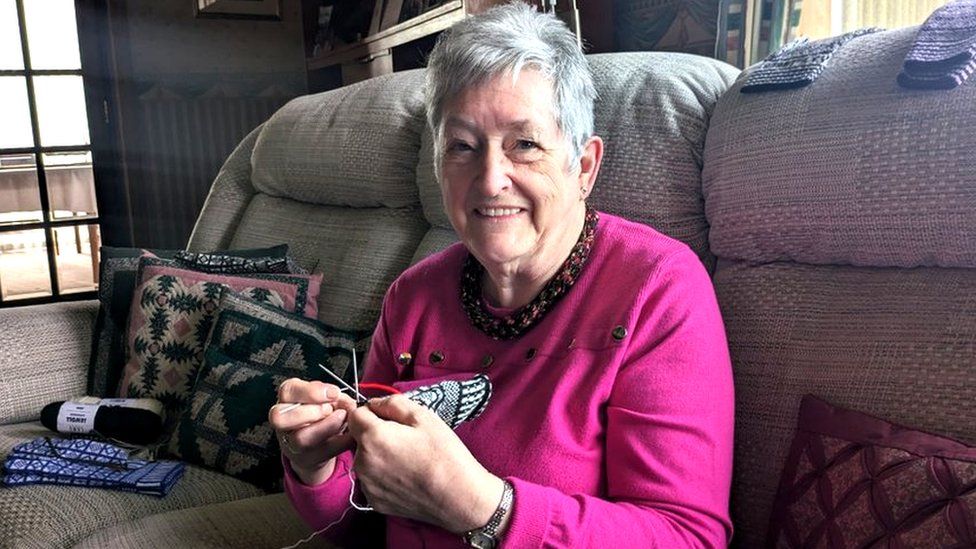Knitter records glove patterns to save Sanquhar designs
- Published

A knitter in Dumfries and Galloway has started a project to save a small but important piece of textile history.
May MacCormick from Sanquhar, is one of the last knitters with full knowledge of Sanquhar glove designs.
The unique items are historically linked to the village and their creation has become a dwindling artform.
Their monochrome designs date back to the 18th century and May is determined to keep the tradition going.
She told BBC Scotland News it was "important" to preserve the cottage industry for posterity.
Sanquhar gloves were traditionally knitted in an intricate, black and white pattern and were sold by villagers to subsidise their income in the 18th and 19th centuries.
May said the majority of designs had never been written down.
There are 16 heritage glove patterns and she has already committed 11 of the patterns to paper.
"These things get lost if they're not recorded and you don't want that in a tradition," she said.
"There are enough gaps in the history of the Sanquhar knitting as it is. We don't know where it originated from, we know it was a cottage industry but we don't know where it came from or when it started."
May shares her knowledge through demonstrations and tours at the A' The Airts community centre in Sanquhar.
Judith Hewitt, Curator for Dumfries and Galloway Museums (East), said: "By the 1770s, it was considered notable that Sanquhar was involved in knitwear and a lot of the people in the town were involved in the knitwear industry.
"It might just be that Sanquhar was on a main artery between Dumfries and Glasgow so it had two areas it could trade with and sell to."
Sanquhar was also well-known for carpet making and one theory is that the gloves originally contained carpet weave, making them stronger and more durable.
The designs were given names such as Cornet and Drum, Fleur de Lys, Prince of Wales, Pheasant's Eye and Shepherd's Plaid.
The most famous pattern, the aristocratic "Duke" design, named after the Dukes of Queensberry and later Buccleuch, may also have raised the knitwear's profile.
Other patterns include a "Midge and Flea" design and a "Rose" pattern, which was named in 1930, after the birth of Princess Margaret Rose.
May learnt the craft from her mother, who had been taught it at the Scottish Women's Institute (SWI) in Sanqhuar.
Like many others, the first design she learnt was the Duke's pattern.
May said: "When I got married and came to Sanquhar, that was when I was introduced to all the other different patterns by a lady who was an authority on it.
"When she decided she was no longer going to knit gloves, she had a glove of every pattern and she asked me if I would like her gloves and if not, they would go to the museum."
May thought the gloves should go to the museum but she asked the woman - Jane Forsyth - if she could make replicas before they went.
Over the last few years, May has been recording the designs.
She said: "There's 10 published, there's an eleventh just about to come out so I'm just working my way through them like that at the minute.
"I write it down as I knit it, that's the way I have done it."
Within the 16 Sanqhuar glove patterns, nine have a squared design, which May knows off by heart.
But she has used her replica gloves to write up the other seven patterns.
She added: "The square patterns were quite easy because the shapings are just the same for all of them, it's what you put in the square that makes it different."
The gloves are knitted on four very small needles in the round so there is no seam.
Part of the tradition is knitting the owner's initials into the cuff, to personalise the gloves.
May said: "The number of stitches you use, the increases, the decreases, everything's the same but it's the size of the needle and the thickness of the wool that makes the difference."
She has been running classes to teach people how to make the Sanquhar gloves and keep the tradition alive.
During the pandemic, there were even online zoom classes, which are now hosted on YouTube.
May very occasionally helps out with the knitting at A' The Airts centre, but mostly knits the gloves on commission, just as her mother did.
"It's just word of mouth really. These are going to a 15-year-old girl," she said, showing off a pair of blue and white gloves.
"I've just finished a pair of boy's gloves and the boy is in his 20s. I'm finding that there's more younger people wanting them now."